Science and Technology: April 2024 UPSC Current Affairs | Science & Technology for UPSC CSE PDF Download
Fukushima Water Issue
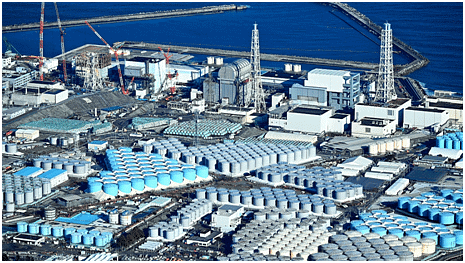
Context
Japan's plan to release over 1 million tons of water, which is claimed to be treated but potentially radioactive, from the Fukushima nuclear power plant into the sea, has sparked strong opposition and anxiety among neighboring countries, particularly South Korea.
What is the Fukushima Water Issue?
- About:
- The Fukushima Daiichi Nuclear power plant suffered a meltdown in 2011 after a massive earthquake and tsunami, releasing large amounts of radioactive materials into the environment.
- No deaths were initially attributed to the incident, although around 18,000 people lost their lives as a result of the earthquake and tsunami.
- Since then, Japan has been storing the cooling water for nuclear fuel and rain and groundwater seeping through the damaged reactor buildings in large tanks on site.
- Recent Developments of the Issue:
- The water is treated using a filtering system called Advanced Liquid Processing System (ALPS), which removes most of the radioactive elements except for tritium, a hydrogen isotope that is difficult to separate.
- Japan says it has no space to keep storing the water, and that releasing it into the sea.
- The International Atomic Energy Agency (IAEA) is assisting Japan to release the water into the sea.
- Raised Concerns:
- South Korea fears that the water release will contaminate its waters, salt and seafood, affecting its fishing industry and public health.
- The increased demand for salt in South Korea has led to a nearly 27% price surge, attributed to both stockpiling and external factors like weather and lower production.
- China has also criticized Japan's plan, questioned its transparency and expressed concerns about the potential impact on the marine environment and global health.
What are the Other Major Nuclear Disasters of the World?
- Chernobyl Disaster (1986): One of the most well-known and severe nuclear disasters, the Chernobyl disaster took place in Chernobyl Nuclear Power Plant in Ukraine.
- A sudden power surge during a safety test led to a series of explosions and fires that destroyed the reactor core and released large amounts of radioactive material into the atmosphere.
- Three Mile Island Accident (1979): This accident occurred in the United States at the Three Mile Island Nuclear Generating Station in Pennsylvania. A partial meltdown of the reactor's core resulted in the release of radioactive gases.
- Kyshtym Disaster (1957): It took place at the Mayak Production Association in the Soviet Union (now Russia).
- It involved a nuclear waste storage tank explosion, releasing a significant amount of radioactive materials into the environment.
What is a Nuclear Power Plant?
- Nuclear power plants are a type of power plant that use the process of nuclear fission in order to generate electricity.
- In nuclear fission, atoms are split apart to form smaller atoms, releasing energy.
- Fission takes place inside the reactor of a nuclear power plant. At the center of the reactor is the core, which contains uranium fuel.
- The heat produced during nuclear fission in the reactor core is used to boil water into steam, which turns the blades of a steam turbine.
- As the turbine blades turn, they drive generators that make electricity.
- Nuclear plants cool the steam back into water in a separate structure at the power plant called a cooling tower, or they use water from ponds, rivers, or the ocean.
- The cooled water is then reused to produce steam.
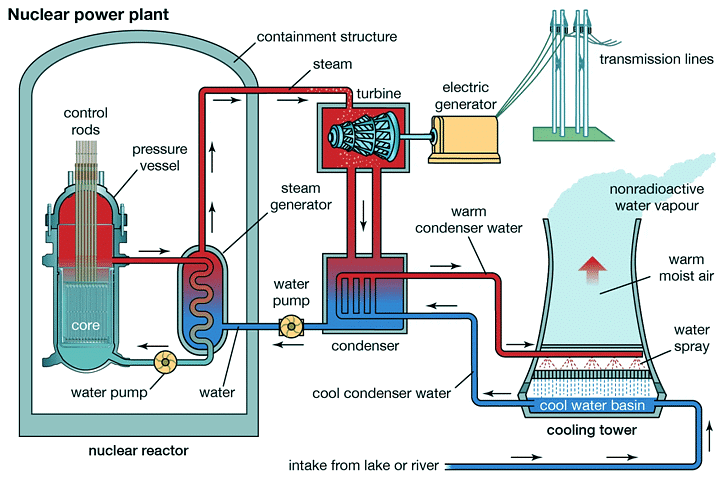
Antiretroviral Therapy (ART) Initiative
Context
April 1 holds significant historical importance in India's response to the HIV/AIDS epidemic. It marks the launch of Antiretroviral Therapy (ART) for Persons living with HIV (PLHIV) by the Indian government twenty years ago, on April 1, 2004. This decision has since been recognized as a successful and crucial intervention in combating HIV/AIDS.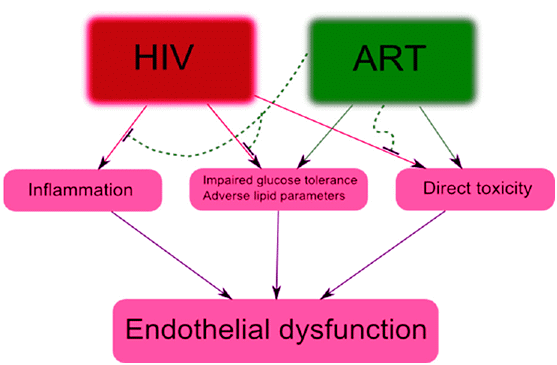
What is HIV/AIDS?
- About:
- HIV/AIDS is a viral infection that attacks the immune system, specifically the CD4 cells (T cells), which help the immune system fight off infections.
- Left untreated, HIV reduces the number of CD4 cells (T cells) in the body, making the person more likely to get infections or infection-related cancers.
- AIDS is the final stage of HIV infection, when the immune system is severely damaged and can no longer fight off infections.
- Causes of HIV/AIDS:
- HIV infection is caused by the human immunodeficiency virus (HIV). The virus is transmitted through contact with infected bodily fluids, such as blood, semen, vaginal fluids, rectal fluids, and breast milk.
- It can be spread through sexual contact, sharing needles or syringes, from mother to child during childbirth or breastfeeding, and rarely, through blood transfusions or organ transplants.
Symptoms of HIV/AIDS:
- Acute HIV Infection:
- Symptoms can resemble those of the flu, including fever, swollen lymph nodes, sore throat, rash, muscle and joint aches, and headache.
- Clinical Latent Infection:
- HIV is still active but reproduces at very low levels. People may not have any symptoms or only mild ones.
- AIDS:
- The symptoms of AIDS are severe and include rapid weight loss, recurring fever or profuse night sweats, extreme and unexplained tiredness, prolonged swelling of the lymph glands in the armpits, groin, or neck, diarrhoea that lasts for more than a week, sores of the mouth, anus, or genitals, pneumonia, and red, brown, pink, or purplish blotches on or under the skin or inside the mouth, nose, or eyelids.
- Diagnosis of HIV/AIDS:
- HIV antibody/antigen tests: These tests detect antibodies or antigens produced by the virus and are usually done on blood or oral fluid.
- Nucleic acid tests (NATs): These tests look for the virus itself and can detect HIV infection earlier than antibody tests.
- Treatment and Management:
- Antiretroviral therapy (ART): ART involves taking a combination of HIV medicines every day. ART can't cure HIV, but it can control the virus, allowing people with HIV to live longer, healthier lives and reducing the risk of transmitting the virus to others.
- Pre-exposure prophylaxis (PrEP): PrEP is a daily pill for people who don't have HIV but are at risk of getting it. When taken consistently, PrEP can reduce the risk of HIV infection.
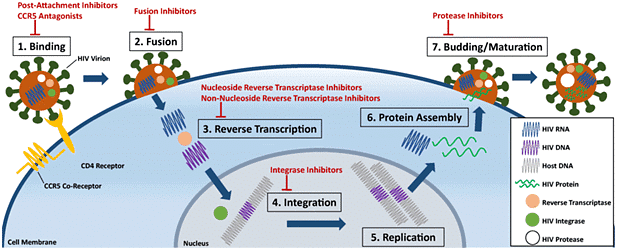
What is Antiretroviral Therapy (ART)?
About:
- Antiretroviral therapy (ART) is a cornerstone treatment for managing HIV/AIDS, a chronic viral infection caused by the human immunodeficiency virus (HIV).
- This therapy aims to suppress the replication of HIV in the body, thereby reducing viral load, preserving immune function, and improving the quality of life for individuals living with HIV/AIDS.
Mechanism of Action of Antiretroviral Therapy:
- Antiretroviral drugs target various stages of the HIV replication cycle, inhibiting viral entry into cells, reverse transcription of viral RNA into DNA, integration of viral DNA into the host genome, and viral assembly and release.
- By disrupting these processes, ART suppresses viral replication and reduces the viral load in the body.
- Components of Antiretroviral Therapy: ART typically consists of a combination of antiretroviral drugs from different classes, including:
- Nucleoside Reverse Transcriptase Inhibitors (NRTIs): These drugs interfere with the reverse transcription process, preventing the conversion of viral RNA into DNA. Examples include tenofovir, emtricitabine, and abacavir.
- Non-Nucleoside Reverse Transcriptase Inhibitors (NNRTIs): NNRTIs bind to and inhibit the activity of the HIV reverse transcriptase enzyme, blocking viral replication. Examples include efavirenz, nevirapine, and rilpivirine.
- Protease Inhibitors (PIs): PIs block the activity of the HIV protease enzyme, preventing the cleavage of viral polyproteins and the maturation of infectious viral particles. Examples include ritonavir, atazanavir, and darunavir.
- Integrase Strand Transfer Inhibitors (INSTIs): INSTIs inhibit the integration of viral DNA into the host genome, preventing the establishment of a permanent viral reservoir. Examples include raltegravir, dolutegravir, and bictegravir.
- Entry Inhibitors: Entry inhibitors block the interaction between viral proteins and host cell receptors, preventing viral entry into cells. Examples include maraviroc and enfuvirtide.
Benefits of Antiretroviral Therapy:
- Viral Suppression: ART reduces the viral load in the body, slowing disease progression and preserving immune function.
- Prevention of Opportunistic Infections: By restoring immune function, ART helps prevent opportunistic infections and AIDS-related complications.
- Improvement in Quality of Life: Effective ART allows individuals living with HIV/AIDS to lead healthier and more productive lives, reducing morbidity and mortality.
- Prevention of Transmission: Viral suppression achieved through ART significantly reduces the risk of HIV transmission to sexual partners and vertical transmission from mother to child during pregnancy and childbirth.
How has the ART Evolved in Ensuring Effective Treatment?
- Evolution:
- At the emergence of HIV/AIDS in the early 1980s, the disease was considered a death sentence and was met with a lot of fear, stigma and discrimination.
- While the US FDA approved the first antiretroviral drug, AZT (zidovudine), in March 1987, three additional drugs were approved in 1988. A new class of antiretroviral drugs, protease inhibitors, was introduced in 1995. However, access to these medicines remained limited for most of the world's population, except in some high-income countries.
- Global Efforts:
- Recognising this challenge, in 2000, at the UN General Assembly’s Millennium Summit, world leaders set a specific goal and issued the declaration to stop and reverse the spread of HIV.
- The Global Fund to Fight AIDS, Tuberculosis and Malaria was created in 2002 which advocated universal access to HIV prevention, treatment, care and support services.
- In 2004, the number of PLHIV in India was estimated to be 5.1 million, with a population prevalence of 0.4%. Very few of them were on antiretroviral therapy. Even by the end of 2004, only 7,000 PLHIV were on ART.
- Barriers to ART’s Evolution:
- The key barrier to ART was high cost and unaffordability for individuals, and geographical access to treatment.
- In fact, the so-called “cocktail therapy’ or HAART (highly active antiretroviral therapy), a combination of three or more anti-retroviral drugs, had become available starting in 1996, but costs were prohibitively high (USD 10,000 a year).
- People infected with HIV were stigmatised and lost their lives while health-care providers felt helpless due to non-availability/non affordability of ARTs.
- Necessity for Free Treatment:
- The decision to make free ART for any adult living with HIV was a path-breaking one. From November 2006, the free ART was made available for children as well.
- In two decades of free ART initiative, the facilities offering ART have expanded from less than 10 to around 700 ART centres - 1,264 Link ART centres have provided, and are providing, free ART drugs to approximately 1.8 million PLHIV on treatment.
- Effectiveness of ART:
- ART is not merely about starting a person living with HIV on treatment. It is equally important to keep the viral load down and suppressed to ensure that the transmission of diseases is also halted.
- The impact has been that in 2023, the prevalence of HIV in 15-49 years has come down to 0.20 (confidence interval 0.17%-0.25%) and the burden of disease in terms of estimated PLHIV has been coming down to 2.4 million.
- Usefulness for Indian Population:
- India’s share in PLHIV globally had come down to 6.3% (from around 10% two decades ago). As of the end of 2023, of all PLHIV, an estimated 82% knew their HIV status, 72% were on ART and 68% were virally suppressed.
- The annual new HIV infections in India have declined by 48% against the global average of 31% (the baseline year of 2010). The annual AIDS-related mortalities have declined by 82% against the global average of 47% (the baseline year of 2010).
What were the Factors that Made ART Intervention Successful?
- Patient-Centric Approach to Services:
- It will be unfair to credit free ART alone for the success. There were many complementary initiatives which have contributed to halting the HIV epidemic.
- These include the provision of free diagnostic facilities; attention on prevention of parent to child transmission of HIV (PPTCT) services; prevention, diagnosis and management of opportunistic infections including management of co-infections such as tuberculosis (TB).
- Incorporating Dynamic Modifications:
- The programme has shown agility and dynamic modifications. Early initiation of ART and Treat all policy evolved over the years where the ART eligibility criteria were relaxed - from those having a CD4 count less than 200 cells/mm3 (in 2004), to that less than 350 cells/mm3 (in 2011), and then to less than 500 cells/mm3 (in 2016).
- Promoting Universalization:
- There was the ‘Treat All’ approach from 2017, which ensures that ART is initiated, irrespective of CD4 count. This has been a true universalisation and has contributed to reduced virus transmission, both at the individual and the community levels.
- Affordable and Free ART:
- The programme also adopted a free of cost viral load testing for all PLHIV on treatment, by providing two to three months of medicines to stable PLHIV which minimises the number of patient visits to the ART centres, reducing travel time and costs for the patients.
- This approach also increases adherence to treatment besides decongesting ART centres by reducing the average daily OPD, giving health-care workers more time to attend to other patients.
- Adding New Medicines:
- India continued to add newer and more potent drugs to the programme, as and when those became available. For example, Dolutegravir (DTG), a new drug with superior virological efficacy and minimal adverse effects was introduced in 2020.
- In 2021, India adopted a policy of rapid ART initiation in which a person was started on ART within seven days of HIV diagnosis, and in some cases, even the same day.
What Steps Need to be Taken to Make ART Treatment More Effective?
- Ensuring Sustained Supply and Availability:
- The sustained supply and availability of ART needs to be ensured by the national programme, in every geography of the country and more so for tough terrain, hilly and remote areas.
- There is a need to focus on the private sector engagement in care of PLHIV, which can ensure efficient supply by deploying their expertise.
- Need for Constant Training:
- This ongoing evolution requires that staff stay updated with the latest advancements and techniques in their field. Moreover, training should emphasise hands-on learning to ensure that staff can effectively apply theoretical knowledge in practical situations.
- This approach not only enhances their skills but also improves their problem-solving abilities and adaptability to new challenges.
- Strengthening Integration with Other Programmes:
- There is a need to focus on strengthening integration with other programmes such as hepatitis, non-communicable diseases (diabetes and hypertension) and mental health as PLHIV are living normal but have other health conditions that need to be addressed.
- A focused approach needs to be adopted to reduce preventable mortality that includes systematic death reviews and availability of advanced diagnostics.
- Adopting a Multi-Sectoral Approach:
- The free ART initiative in India can be made more effective by ensuring the political will and constant support of successive governments; sustained and sufficient funding, regular programme reviews and field-based monitoring, a series of complementary initiatives; community and stakeholder engagements and participation; people-centric modifications in the service delivery; bridging the policy intentions to implementation gaps, and continuous expansion of services to cover more people living with HIV.
- Implementing National AIDS Control Programme (NACP):
- The ongoing and fifth phase of India’s National AIDS Control programme (NACP) aims to (by 2025) reduce the annual new HIV infections by 80%, reduce AIDS-related mortalities by 80% and eliminate vertical transmission of HIV and syphilis.
- To achieve this, NACP phase 5 calls for the attainment of ambitious targets of 95-95-95 by 2025, where 95% of all people living with HIV know their HIV status; 95% of all people diagnosed with HIV infection receive sustained antiretroviral therapy (ART), and 95% of all people receiving antiretroviral therapy achieve viral suppression by 2025. These targets are aligned with global targets agreed by the UNAIDS.
Kodaikanal Solar Observatory
Context
Recently, Kodaikanal Solar Observatory celebrated its 125th birth anniversary. Over the years, it has played a crucial role in advancing our understanding of solar activity and its impact on Earth's climate and space weather.
What is a Solar Observatory?
- About: A solar observatory is a facility or institution dedicated to observing and studying the Sun.
- These observatories use specialised telescopes and instruments to observe various phenomena on the Sun's surface, in its atmosphere, and in the surrounding space.
- Need: The Sun serves as the main source of energy for life on Earth, and alterations in its surface or surrounding areas have the potential to greatly impact our Earth’s atmosphere.
- Intense solar storms and Solar flares pose significant risks to satellite operations, power grids, and navigation systems reliant on space-based technology.
- Through solar observatories, scientists can monitor these events and predict major events that can have an impact on earth’s atmosphere.
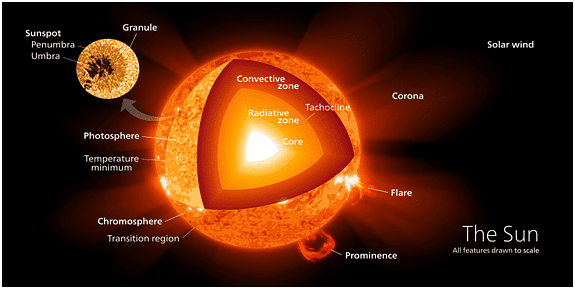
What is the Kodaikanal Solar Observatory?
- About: The Kodaikanal Solar Observatory is a solar observatory owned and operated by the Indian Institute of Astrophysics. It was established in 1899.
- It is on the southern tip of the Palani Hills.
- The Evershed effect (apparent radial flow of gas observed in the penumbra (outer region) of sunspots on the Sun )was first detected at this observatory in January 1909.
- Cause of Establishment: The establishment of the Kodaikanal Solar Observatory (KoSO) in India, was motivated by the need to understand the link between solar activity and monsoons.
- The devastating Great Drought of 1875-1877 in India highlighted the potential link between solar activity and seasonal rainfall patterns.
- India, along with China, Egypt, Morocco, Ethiopia, southern Africa, Brazil, Columbia and Venezuela, suffered concurrent multi-year droughts during 1876-1878, later named the Great Drought, and an associated global famine that killed nearly 50 million.
- The Famine Commission recommended establishing a solar observatory for systematic solar observations to understand this connection.
- Charles Michie Smith, a physicist, was entrusted with finding a suitable location.
- Kodaikanal in Tamil Nadu was chosen for its clear skies, low humidity, and minimal fog.
- Madras Observatory (Chennai, 1792): In 1792, the British East India Company established the Madras Observatory, a first of its kind in this part of the world.
- Here, astronomical observations of the Sun, the Moon, bright stars and planets recorded during 1812-1825 were preserved in two large data volumes.
- It was merged with the KoSO following the reorganisation of all Indian observatories in April 1899.
What are the Other Major Space Observatories Established in India?
- Indian Astronomical Observatory (IAO), Hanle: It is situated in Hanle Ladakh and one of the country's premier astronomical facilities.
- It is operated by the Indian Institute of Astrophysics and plays a vital role in advancing India's contributions to the field of astronomy and astrophysics.
- Mt. Abu Infrared Observatory (MIO): It is situated at the top of Mount Abu (at Gurushikhar) in the Aravalli Range of Rajasthan, India.
- It is operated by the Physical Research Laboratory (PRL).
- Infrared astronomy involves observing celestial objects and phenomena in the infrared portion of the electromagnetic spectrum.
- Giant Metrewave Radio Telescope: It is a prominent radio astronomy facility located near Pune, India.
- Operated by the National Centre for Radio Astrophysics (NCRA), the GMRT comprises 30 fully steerable parabolic radio telescopes spread over a large area.
- Its design is based on the SMART Concept: Stretch Mesh Attached to Rope Trusses.
Shallow Fakes
Recently, the viral video featuring US Vice President Kamala Harris making irrational remarks points toward the threat society faces regarding shallow fakes.
- Shallow fakes or cheap fakes are pictures, videos, and voice clips created without the help of Artificial Intelligence (AI) technology but by either editing or by using other simple software tools.
- Deepfakes are synthetic media that use AI to manipulate or generate visual and audio content, usually intending to deceive or mislead someone.
- These are created using a technique called generative adversarial networks (GANs), which involve two competing neural networks: a generator and a discriminator.
- Global Risk Report 2024, by the World Economic Forum (WEF), also highlighted AI-powered misinformation and Disinformation as the most severe risks in the next 2 years.

First Home-Grown Gene Therapy For Cancer
Context
- The President of India launched India’s first home-grown gene therapy for cancer at IIT Bombay.
- India’s first CAR-T cell therapy is developed through collaboration between the Indian Institute of Technology, Bombay and Tata Memorial Hospital in association with industry partner ImmunoACT.
About CAR-T Cell Therapy
- CAR-T cell therapy, or chimeric antigen receptor T-cell therapy, is a type of immunotherapy that harnesses the power of the immune system to target and destroy cancer cells.
- It involves genetically modifying a patient's own T cells to express chimeric antigen receptors (CARs), which enable the T cells to recognize and attack cancer cells with specific surface antigens.
Mechanism of Action
- T cells are collected from the patient's blood through leukapheresis and genetically engineered to express CARs targeting a specific antigen present on cancer cells.
- CARs consist of an extracellular antigen recognition domain, a transmembrane domain, and an intracellular signaling domain.
- Upon infusion back into the patient, CAR-T cells recognize cancer cells expressing the target antigen and initiate a cytotoxic immune response, leading to the destruction of cancer cells.
Development and Manufacturing Process
- The process begins with isolating T cells from the patient's blood sample and activating them using cytokines like interleukin-2 (IL-2). These T cells are then genetically modified using viral vectors (such as lentiviral or retroviral vectors) to introduce the CAR gene into their genome.
- Subsequently, the modified CAR-T cells undergo in vitro expansion to reach sufficient quantities for therapeutic infusion. Rigorous quality control tests are conducted to ensure the safety, purity, and potency of the CAR-T cell product before it is administered to the patient.
Clinical Applications
- CAR-T cell therapy has demonstrated impressive effectiveness in the treatment of specific hematologic malignancies, including acute lymphoblastic leukemia (ALL), B-cell non-Hodgkin lymphoma (NHL) such as diffuse large B-cell lymphoma (DLBCL) and follicular lymphoma, and chronic lymphocytic leukemia (CLL).
- Ongoing research is investigating the potential of CAR-T cell therapy for treating solid tumors like glioblastoma, ovarian cancer, and pancreatic cancer.
Side Effects
- CAR-T cell therapy is associated with potentially severe side effects, notably cytokine release syndrome (CRS) and neurologic toxicities. CRS manifests as fever, flu-like symptoms, hypotension, and organ dysfunction due to the release of pro-inflammatory cytokines by activated T cells. Neurologic toxicities may include confusion, delirium, seizures, and aphasia, resulting from immune-mediated inflammation in the central nervous system.
- Early identification and management of these side effects are critical, typically involving supportive care, anti-cytokine therapies (such as tocilizumab and corticosteroids), and close monitoring in an intensive care setting when necessary.
About Cancer
- Cancer is a diverse group of diseases characterized by abnormal cell growth and proliferation. It can develop in any tissue or organ of the body when normal cellular processes controlling growth, division, and death are disrupted, leading to uncontrolled cell growth and the formation of tumors.
Types of Cancer
- Carcinomas: Arise from epithelial cells lining organs or cavities, such as lung, breast, prostate, and colon cancers.
- Sarcomas: Originate from connective tissues like bone, muscle, and cartilage.
- Leukemias: Develop in blood-forming tissues like bone marrow, leading to abnormal white blood cell proliferation.
- Lymphomas: Affect the lymphatic system, causing abnormal growth of lymphocytes (white blood cells).
- Central Nervous System (CNS) Tumors: Occur in the brain or spinal cord, including gliomas, meningiomas, and medulloblastomas.
Causes and Risk Factors
- Genetic Factors: Inherited mutations in genes like BRCA1 and BRCA2 increase the risk of certain cancers.
- Environmental Factors: Exposure to carcinogens such as tobacco smoke, ultraviolet radiation, asbestos, and certain chemicals raises cancer risk.
- Lifestyle Factors: Unhealthy habits like smoking, excessive alcohol consumption, poor diet, lack of physical activity, and obesity contribute to cancer development.
- Viral Infections: Infections with oncogenic viruses like HPV, HBV, and EBV can lead to specific cancers.
About Gene Therapy
- Gene therapy is an innovative approach to treating genetic disorders by modifying or replacing defective genes. It has the potential to address a wide range of diseases, including inherited disorders, cancers, and certain viral infections, by correcting underlying genetic abnormalities.
Types of Gene Therapy
- Gene Addition Therapy: Introduces a functional gene copy into cells to compensate for a defective or missing gene.
- Gene Editing Therapy: Uses molecular tools like CRISPR-Cas9 to precisely modify DNA sequences, correcting mutations or disrupting disease-causing genes.
- Gene Silencing Therapy: Suppresses specific gene expression using RNA interference (RNAi) or antisense oligonucleotides to treat conditions caused by overactive genes.
Steps in Gene Therapy
- Identification of Target Gene: The defective gene responsible for the disease is identified through genetic testing.
- Gene Delivery: Therapeutic genes are transported into target cells using viral vectors or non-viral methods like nanoparticles.
- Gene Expression: Therapeutic genes integrate into the genome or produce functional proteins, restoring normal cellular function.
- Monitoring and Follow-Up: Patients are monitored for treatment efficacy and potential side effects, with long-term follow-up to assess treatment durability.
Applications of Gene Therapy
- Monogenic Disorders: Promising for treating single-gene disorders like cystic fibrosis, sickle cell disease, muscular dystrophy, and hemophilia.
- Cancer Treatment: Investigated for various cancers using oncolytic viruses and gene-editing techniques targeting genetic mutations or enhancing immune responses.
- Neurological Disorders: Potential treatment for neurological conditions like Parkinson's disease, Alzheimer's disease, and spinal muscular atrophy.
- Infectious Diseases: Explored for combating viral infections such as HIV/AIDS, hepatitis, and COVID-19.
Challenges
- Delivery Efficiency: Ensuring effective delivery of therapeutic genes with minimal off-target effects remains a challenge.
- Immune Response: Immune reactions to viral vectors or foreign DNA may limit therapy effectiveness.
- Long-Term Safety: Risks like insertional mutagenesis and unintended gene silencing require rigorous safety assessments and patient monitoring.
- Ethical and Social Implications: Complex societal issues surrounding gene editing and equitable access to therapy necessitate careful consideration of ethical implications.
3-D Map of the Universe
Context
A groundbreaking three-dimensional map of the universe has recently been unveiled by an international team of researchers.
- Experts anticipate that this achievement could provide valuable insights into the nature of Dark Energy. Generated from the initial year of observations conducted by the Dark Energy Spectroscopic Instrument (DESI), this map provides detailed information on the arrangement of galaxies and presents potential for advancing our understanding of Dark Energy's enigmatic properties.
What are the Universe's Fundamental Components?
- The universe is made up of three components:
- Normal or visible matter (5%)
- Dark matter (27%),
- Dark energy (68%)
- Normal Matter:
- Normal matter makes up everything we can directly observe.
- It is composed of atomic particles like protons, neutrons, and electrons.
- It can exist as gas, solid, liquid, or plasma of charged particles.
- Dark Matter:
- Like ordinary matter, dark matter takes up space and holds mass.
- Dark matter is invisible and does not interact with light, making it impossible to directly observe.
- It exerts gravitational influence, as evidenced by its impact on the motion of stars, gas, and galaxies.
- Dark matter is believed to form halos around galaxies, and it is more prevalent in dwarf galaxies compared to larger ones.
- Dark Energy:
- Dark energy is a mysterious force that counteracts gravity, causing the expansion of the universe to accelerate.
- Despite being invisible like dark matter, dark energy has a different effect, pushing galaxies apart instead of pulling them together.
- The discovery of dark energy in 1998 was based on measurements of cosmic expansion, which revealed an increasing rate of expansion.
- Nature of Dark Energy:
- The recent findings have raised the tantalising possibility that dark energy – a mysterious, repulsive force that drives the process – is not constant throughout time as has previously been suggested.
- Dark Energy is detected by its effect on the rate at which the universe expands and its effect on the rate at which large-scale structures such as galaxies and clusters of galaxies form through gravitational instabilities.
Exploring the Durability of Modern Vaccines
Context
Recently, in a review of several vaccines, it has been found that only five vaccines provide long-lasting protection spanning more than 20 years and only three provide lifelong protection. The variability in vaccine efficacy poses challenges concerning its effectiveness and longevity.
What are Vaccines and Immunological Mechanism?
- About:
- Vaccines are biological preparations designed to stimulate the body's immune system to recognise and fight against specific pathogens, such as viruses or bacteria, without causing the disease itself.
- They typically contain weakened or inactivated forms of the pathogen, parts of the pathogen, or toxins produced by the pathogen.
- Immunological Mechanism :
- Memory B Cells: Formed in lymph nodes after vaccination, they "memorise" antigens and trigger rapid antibody production upon subsequent exposure to the same antigen.
- T Cell Support: Memory B cells require T cell support vaccines that stimulate T cells can induce the production of memory B cells.
- Variability in Vaccine-Induced B Cell Response: Not all vaccines prompt the body to produce memory B cells. Some vaccines require frequent boosters to enhance immunity duration.
- Example: Measles and rubella vaccines maintain constant levels of memory B cells in blood plasma, correlating with antibody levels for decades. However, this is not observed with chickenpox, tetanus, and diphtheria vaccines.
- Long-Lasting Plasma Cells (LLPCs): Migrate to the bone marrow and may endure for decades, playing a crucial role in vaccine-induced immunity.
- LLPCs are essential for lifelong protection, termed the immunology "holy grail." Vaccines aim to generate LLPCs for sustained immunity.
- Some vaccines, like mRNA Covid-19 shots, fail to activate LLPCs in the bone marrow, potentially impacting long-term protection.
- Variability in Vaccine Efficacy: Different vaccines differ in their ability to produce memory B cells and LLPCs, leading to discrepancies in durability and effectiveness.
- Vaccine and its Efficacy:
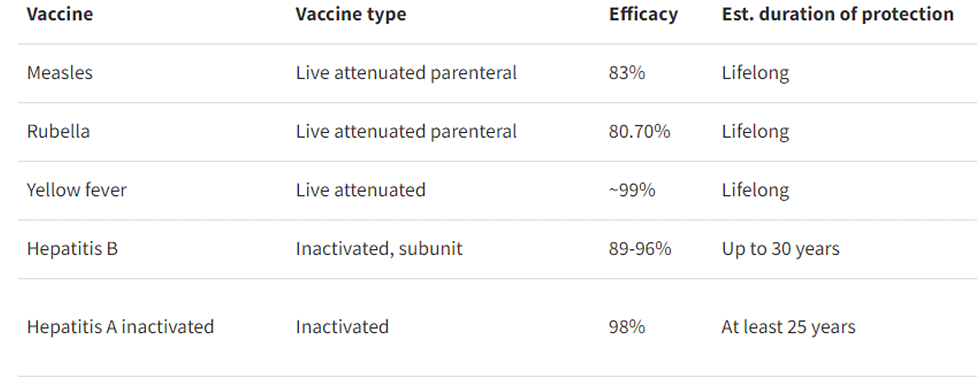
What Factors Influence the Efficacy of Vaccines?
Vaccine efficacy is influenced by three primary categories of factors, i.e., vaccine related, pathogen related and host related.
- Vaccine Related:
- Live Viral Vaccinations: It Includes the vaccines for measles, rubella, yellow fever, chickenpox, and polio (oral) provide long lasting protection than killed pathogen or subunit vaccines.
- Interval Between Vaccine Doses: A long interval of at least six months between priming and booster doses is crucial for a robust immune response.
- Target Pathogen Related:
- Pathogens with Mucosal Infections: Viruses causing mucosal infections like SARS-CoV-2 and influenza lead to frequent reinfections due to their quick transmission before the immune system can mount a response.
- Genetic Stability of Virus: RNA viruses like measles and SARS-CoV-2, with high mutation rates, may require vaccine updates.
- Measles vaccine has remained stable, while SARS-CoV-2 vaccines have been updated due to mutations.
- Host-Related Factors:
- Age, Gender, and Obesity: These factors influence vaccine efficacy and duration of immunity. Extreme ages and obesity may lead to shorter-lasting immune responses.
Semiconductor Chip Manufacturing Technology
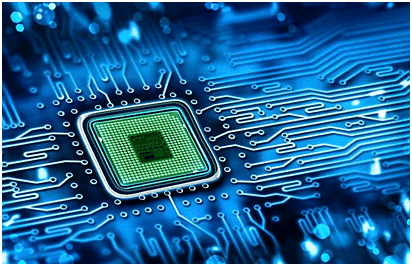
Context
The TATA Group has partnered with Taiwan's PSMC to set up a 300 mm wafer fabrication facility in Gujarat, aiming to introduce its first 28 nm chip by 2026. Additionally, the Indian Government has approved the establishment of two assembly and test plants in Gujarat and Assam.
What is a Semiconductor Chip?
- About:
- Semiconductor: Semiconductors possess electrical conductivity properties intermediate between conductors and insulators, which can be modified by introducing dopants.
- Semiconductor chips, transistors, fabrication technology, and wafers are interdependent components essential for electronic device functionality.
- Transistors serving as the building blocks of semiconductor chips fabricated on wafers using specific technologies, enabling the creation of complex devices powering modern technology.
- Semiconductor Chips:
- It is a tiny electronic device made of semiconductor material (usually silicon or germanium) which serves as the basic building block of most electronic circuits.
- These chips can contain billions of microscopic switches on a chip smaller than a fingernail.
- The basic component of a semiconductor chip is a silicon wafer etched with tiny transistors that control the flow of electricity according to various computational instructions.
- It performs various functions, such as processing data, storing information, or controlling electronic devices.
- They are a critical part of almost every modern electronic device, including smartphones, computers, and integrated circuits.
- Transistor:
- Transistors are fundamental components of semiconductor devices that amplify or switch electronic signals and electrical power.
- They are the building blocks of modern electronic devices and are used in various applications, including amplifiers, switches, and digital circuits.
- Fabrication Technology:
- Fabrication technology refers to the process of creating semiconductor devices like chips and transistors. It involves several key steps, including wafer preparation, photolithography, etching, doping, and packaging.
- Wafer:
- A wafer (also called a slice or substrate) is a thin slice of semiconductor material, such as crystalline silicon, used for the fabrication of integrated circuits.
- A semiconductor chip is produced by printing an array of chips on a circular semiconductor wafer, similar to how postage stamps are printed on a sheet and then cut out individually.
- Larger wafer sizes in the industry enable more chips to be printed on a single wafer, accelerating and reducing the cost of chip production, despite the technical challenges and initial capital expenses involved.
What is the Status of India’s Semiconductor Ecosystem?
- India is actively working towards building a strong semiconductor ecosystem, leveraging its substantial market potential, skilled talent pool, and government backing to decrease reliance on imports and foster local manufacturing capabilities.
- The country's well-established chip design sector since the 1990s will bolster its semiconductor manufacturing initiatives, providing diverse opportunities for professionals beyond electronics and computer engineering.
- Key Advantages:
- Market Potential: India's rapidly expanding population and growing middle class generate significant demand for semiconductor products. The semiconductor market in India is forecasted to reach $55 billion by 2026, underscoring its commitment to domestic manufacturing.
- Talent Pool: India places a strong emphasis on skill development and innovation, nurturing local chip design expertise.
Green Steel Policy
Context
Steel Ministry is developing a comprehensive green steel policy, encompassing the manufacturing process, required skill set, and funding support, as part of a complete decarbonization strategy.
What is Green Steel?
- About:
- Green steel is the eco-friendly production of steel with lower greenhouse gas emissions, possibly reducing costs and enhancing quality compared to traditional methods.
- Need:
- High Coal Consumption in Blast Furnace: The steel manufacturing process, involving blast furnaces, basic oxygen furnaces, and electric arc furnaces, is a major global source of carbon emissions, primarily due to the high coal and coke consumption in blast furnace operations.
- A study suggests that with steel demand projected to rise through the 21st century, there is a strong incentive to seek low greenhouse gas (GHG) emission alternatives for steel production.
- India's domestic steel sector contributes 12% of the country's greenhouse gas emissions, with an emission intensity of 2.55 tonnes of CO2 per tonne of crude steel, higher than the global average of 1.9 tonnes of CO2.
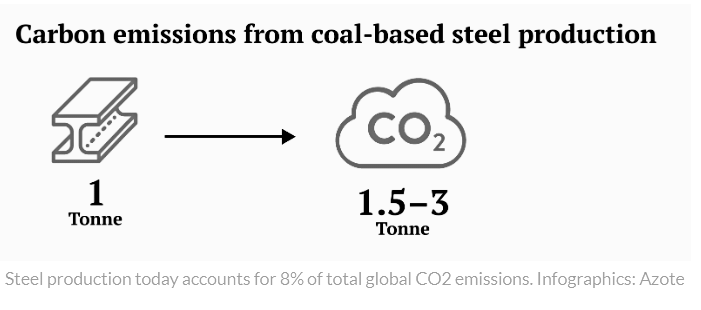
- As a Low-Grade Carbon Production Method:
- It Includes carbon capture and storage (CCS), using Green/Blue hydrogen, high biomass utilization, and artificial iron units (AIUs) for reducing carbon emissions and producing high-grade steel.
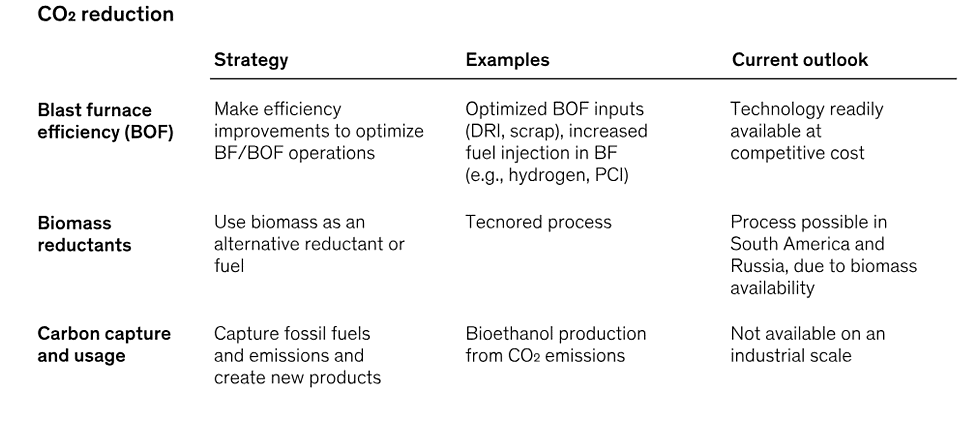
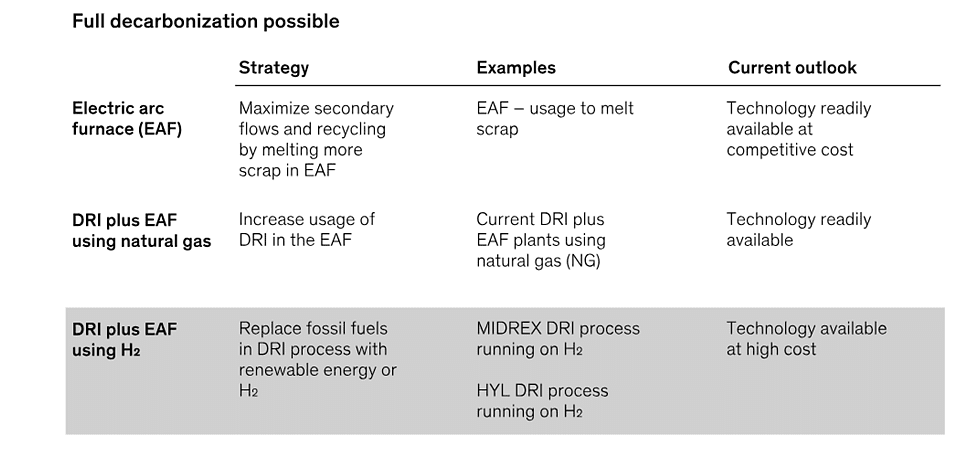
Global Initiatives
- First Movers Coalition:
- The World Economic Forum's initiative aims to decarbonize industrial sectors like steel.
- The Coalition has expanded, with 55 companies and nine countries committing to sourcing a portion of their industrial materials and transport needs from suppliers using near-zero or zero-carbon solutions.
- Industrial Deep Decarbonization Initiative (IDDI):
- This initiative encourages governments to disclose environmental data and adopt low-emission or near-zero emissions cement and steel in construction projects.
- Nine countries, including the U.S., have joined this effort and are preparing to announce their commitments.
- SteelZero and ConcreteZero:
- The Climate Group’s SteelZero and ConcreteZero initiatives involve partnerships with 25 and 22 companies, respectively.
- These initiatives commit to using net-zero steel and low- or net-zero emission concrete, recognizing cement as a crucial component.
- European Union:
- By 2030, the European Union is expected to host nearly 50 green and low-carbon steel projects, partly driven by policies like the Carbon Border Adjustment Mechanism.
- Sweden:
- Hybrit has supplied Volvo with the first coal-free "green steel," showcasing efforts towards environmentally friendly steel production.
- H2 Green Steel is constructing a fossil fuel-free steel plant in Sweden with a sustainable hydrogen facility, aiming to advance sustainable steel production.
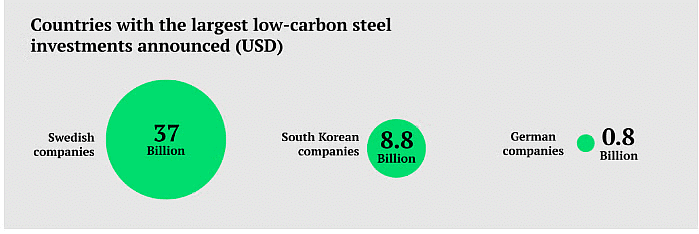 India’s Initiative:
India’s Initiative:- The Steel Ministry is developing a green steel policy, including process definition, required skills, and funding, with a focus on complete decarbonization.
- Already 13-odd task forces had been formed to determine the various modalities around green steel-making, including a definition of the offering.
- Recently, the 14th task force was set up to explore the option of using biochar or biomass (as an alternative in blast furnaces) in steel-making, thereby bringing down carbon emissions during the manufacturing process.
- India is exploring its own pure-hydrogen-based DRI (direct reduction of iron) technology, with the project report currently under scrutiny, and also considering a consortium-based pilot for a hydrogen-based DRI facility.
- The Ministry of New and Renewable Energy has allocated ₹455 crore for piloting the use of hydrogen in steel making.
Ozone Found on Jupiter’s Moon Callisto
Context
A multinational team of scientists, including researchers from India, has discovered strong evidence indicating the presence of ozone on Callisto, one of Jupiter's moons.
- Previously regarded as a desolate celestial body, scientists now believe that this icy moon may have conditions suitable for supporting life.
What are the Key Features of Callisto?
- About: Callisto ranks as one of Jupiter’s largest moons and is the third-largest moon in the Solar System, following Ganymede (Jupiter) and Titan (Saturn).
- It was discovered in 1610, by Italian scientist Galileo Galilei along with Jupiter’s three other largest moons: Ganymede, Europa and Io.
- As per NASA, after Saturn (146), Jupiter (95) boasts the highest number of moons in the Solar System.
- Features: It is primarily composed of water ice, rocky materials, sulfur dioxide, and organic compounds.
- Its surface is heavily cratered, indicating a long history of being struck by asteroids and comets.
- It also lacks the extensive seismic activity seen on some of Jupiter’s other moons, such as Io and Europa.
What are Some Other Potentially Habitable Celestial Bodies?
Habitable Zone: Habitable zone is the distance from a star at which liquid water could exist on orbiting planets’ surfaces.
Habitable zones are also known as Goldilocks’ zones, where conditions might be just right (neither too hot nor too cold) for life.
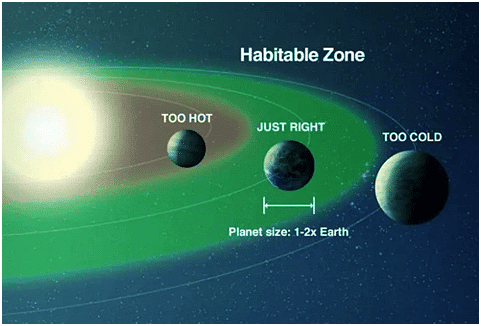
- Potential Habitable Celestial Bodies
- Kepler 22b: It is the first planet confirmed by NASA's Kepler mission to orbit within the habitable zone of a sun-like star.
- The planet, 2.4 times the size of Earth, resides in a region where liquid water could potentially exist, vital for sustaining life.
- Proxima Centauri b: Proxima Centauri b is an exoplanet, which is a planet that orbits a star other than our sun.
- It is located in the habitable zone of its star, which means that it is the right distance from the star to potentially have liquid water on its surface.
- Proxima Centauri b is also very close to Earth, at only 4.2 light-years away.
- TRAPPIST-1 System (Star System): The TRAPPIST-1 system is a group of seven Earth-sized planets orbiting an ultra-cool dwarf star about 39 light-years away.
- Several of the planets within the TRAPPIST-1 system are located within the habitable zone, and some may have liquid water on their surfaces.
Energy Efficiency in Construction Sector
Context
India's unprecedented construction sector boom has brought forth economic opportunities and improved living standards, but it also poses significant environmental challenges. Addressing energy inefficiency in residential buildings becomes crucial amidst this scenario.
Why is Addressing Energy Inefficiency in India's Construction Sector Important?
- Addressing energy inefficiency in residential buildings is crucial, given India's rising energy and cooling demand due to economic growth, urbanisation, heat islands, and climate change.
- The construction sector in India is witnessing an unprecedented boom, with over 300,000 housing units erected annually. This growth brings economic opportunities and improved living standards but poses significant environmental challenges.
- The building sector accounts for over 33% of India's electricity usage, contributing to environmental degradation and climate change.
- The India Cooling Action Plan forecasts an eightfold increase in cooling demand between 2017 and 2037, emphasising the need for thermal comfort while reducing active cooling demand.
- Improving energy efficiency offers a significant opportunity to reduce energy consumption and associated greenhouse gas (GHG) emissions.
- Well-designed, energy-efficient buildings offer better indoor air quality, thermal comfort, and natural lighting, enhancing occupant well-being.
What are India’s Initiatives Regarding the Energy Efficiency in the Construction Sector?
- Eco-Niwas Samhita (ENS):
- ECO Niwas Samhita is an Energy Conservation Building Code for Residential Buildings (ECBC-R) launched by the Ministry of Power in December 2018.
- The code aims to promote energy efficiency in the design and construction of homes, apartments, and townships for the benefit of occupants and the environment.
- The Bureau of Energy Efficiency (BEE) is the statutory body responsible for implementing policies and programs in energy efficiency and conservation.
- The ENS introduced the Residential Envelope Transmittance Value (RETV), a metric measuring heat transfer through a building's envelope (walls, roof, and windows).
- Lower RETV values lead to cooler indoor environments and decreased energy usage for cooling.
- The ENS recommends maintaining an RETV of 15W/m² or less for optimal efficiency, improved occupant comfort, and lower utility expenses.
- Energy Conservation Building Code (ECBC):
- The Energy Conservation Building Code (ECBC), initiated by the Bureau of Energy Efficiency (BEE) in 2007 and updated in 2017, sets minimum energy standards for commercial buildings.
- It aims to achieve energy savings of 25 to 50% in compliant buildings and applies to commercial buildings with a significant connected load.
- ECBC primarily focuses on six components of building design, including envelope, lighting systems, Heating, Ventilation, and Air Conditioning. (HVAC) systems, and electrical power systems.
- The updated 2017 code prioritises renewable energy integration, ease of compliance, inclusion of passive building design strategies, and flexibility for designers.
- It offers tags of efficiency ranging from ECBC to Super ECBC based on compliance levels.
- Energy Conservation (Amendment) Act, 2022:
- Energy Conservation (Amendment) Act, 2022 provides for the transitioning of ECBC into the Energy Conservation and Sustainability Building Code by incorporating measures relating to embedded carbon, net zero emissions, materials and resource efficiency, deployment of clean energy, and circularity.
- Energy Conservation (Amendment) Act, 2022 also makes ECO Niwas Samhita, the residential building energy code, mandatory.
- NEERMAN Awards:
- National Energy Efficiency Roadmap for Movement towards Affordable & Natural Habitat(NEERMAN) Awards, recognized and encouraged buildings that comply with the Energy Conservation Building Code 2017 (ECBC 2017).
- The awards were a part of the 'Azadi Ka Amrit Mahotsav' initiative.
- BEE Star Rating for Buildings:
- BEE Star Rating for Buildings is a unique tool, which is developed to assess the status of Energy Efficiency in Commercial Buildings.
- This rating system is applicable to buildings with the connected load of 100 kW or greater.
- Under this system of evaluation, 1-5 stars are awarded based on the building's energy usage.
- The rating is based upon different criteria such as built-up area, conditioned and unconditioned areas, type of building, hours of operation of building in a day, climatic zone and other miscellaneous information related to facility.
- Green Rating for Integrated Habitat Assessment (GRIHA):
- GRIHA is a national rating system for green buildings that is adopted while designing and evaluating new buildings. This tool has been adopted by the Ministry of New and Renewable Energy.
- Indian Green Building Council (IGBC):
- The IGBC, part of the Confederation of Indian Industry (CII) was formed in the year 2001. The vision of the council is, “To enable a sustainable built environment for all and facilitate India to be one of the global leaders in the sustainable built environment by 2025”.
How can the Construction Sector Become Energy Efficient?
- Utilisation of Autoclaved Aerated Concrete (AAC) Blocks:
- An analysis across four warmer climate cities in India compared the popularity of materials like Autoclaved Aerated Concrete (AAC) blocks, red bricks, fly ash, and monolithic concrete (Mivan).
- ACC is concrete that has been manufactured to contain closed air pockets. AAC is one-fifth the weight of concrete.
- AAC blocks exhibit superior thermal efficiency across various climatic conditions.
- They have the lowest RETV compared to other materials, indicating their potential for energy efficiency.
- AAC blocks offer a better balance between embodied energy and construction time compared to red bricks and monolithic concrete.
- Exploring Innovative Building Materials:
- India possesses untapped potential for innovative building materials.
- Interdisciplinary collaborations with sustainability experts can optimise strategies for energy-efficient building design.
- Addressing Sustainability Concerns:
- The construction industry's preference for materials like monolithic concrete raises concerns due to high embodied carbon and thermal discomfort.
- Monolithic construction is a method by which walls and slabs are constructed together.
- Sustainable construction requires innovation from manufacturers to develop cost-effective and resilient solutions.
- Promoting Sustainable Practices:
- Re-imagining construction practices and fostering a culture of sustainability can significantly enhance energy efficiency and environmental sustainability.
- Cost-effective, durable, and climate-resilient building materials can contribute to improved quality of life and align with environmental goals.
- Adoption of Smart Building Systems:
- Smart building systems, Artificial Intelligence, 3D Printing and the Internet of Things (IoT) should be integrated into construction projects to optimise energy consumption.
- Deploy intelligent HVAC systems that adjust based on occupancy to minimise energy consumption while ensuring occupant comfort.
- Embrace 3D printing for creating energy-efficient building components with minimal material waste.
Coordinated Lunar Time

Context
Lately, the US White House has formally instructed NASA to establish a time standard specifically for the Moon. This standard will be utilized by various international organizations and private enterprises to synchronize their operations on the lunar surface.
About Coordinated Lunar Time (LTC)
- The Lunar Time Standard (LTC) will establish a crucial time-keeping reference for lunar spacecraft and satellites, requiring exceptional precision for their missions.
- LTC will facilitate synchronized communication among satellites, astronauts, bases, and Earth, ensuring seamless coordination.
- A unified time standard is vital for coordinating operations, ensuring transaction reliability, and managing logistics for lunar commerce.
- The need for LTC arises due to the difference in gravitational effects between the Moon and Earth, causing time to tick slightly faster on the Moon relative to Earth.
- On the Moon, an Earth-based clock would appear to lose approximately 58.7 microseconds per Earth day, with additional periodic variations.
- This time difference can pose challenges for spacecraft docking, scheduled data transfers, communication, and navigation tasks.
How does Earth’s time standard work?
- Most of the clocks and time zones of the world are based on Coordinated Universal Time (UTC) which is essentially an internationally agreed upon standard for world time.
- It is set by the International Bureau of Weights and Measures in Paris, France.
- It is tracked by a weighted average of more than 400 atomic clocks placed in different parts of the globe.
- Atomic clocks measure time in terms of the resonant frequencies — the natural frequency of an object where it tends to vibrate at a higher amplitude — of atoms such as cesium-133.
- In atomic time, a second is defined as the period in which a caesium atom vibrates 9,192,631,770 times. As the vibration rates at which atoms absorb energy are highly stable and ultra-accurate, atomic clocks make for an excellent device for gauging the passage of time.
- To obtain their local time, countries need to subtract or add a certain number of hours from UTC depending on how many time zones they are away from 0 degree longitude meridian, also known as the Greenwich meridian.
- If a country lies on the west of the Greenwich meridian, it has to subtract from the UTC, and if a country is located on the east of the meridian, it has to add.
ISRO’s ‘Zero Orbital Debris’ Milestone
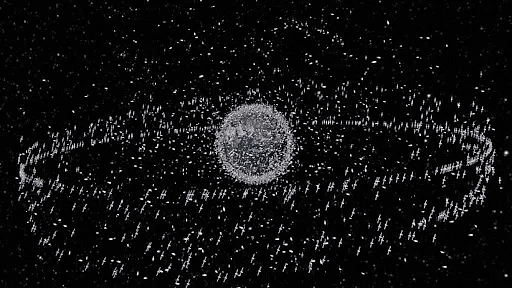
Context
ISRO conducted a mission named PSLV-C58/XPoSat and ensured it produced no space debris by repurposing the final stage of the rocket into a compact space station named POEM-3 (PSLV Orbital Experimental Module-3). Rather than allowing it to remain adrift in space, they guided it back into Earth's atmosphere once the mission concluded.
What is POEM?
- About
- It has been developed by the Vikram Sarabhai Space Centre (VSSC) as an inexpensive space platform.
- It uses the spent fourth stage of a PSLV rocket as an orbital platform.
- Used for the first time in the PSLV-C53 mission in June 2022, ISRO had POEM orbit the earth as a stabilised platform to perform in-orbit scientific experiments with various payloads.
- Features
- POEM is powered by solar panels mounted on the fuel tank of the rocket’s fourth stage and a lithium-ion (Li-ion) battery.
- It has a dedicated navigation, guidance, and control (NGC) system to stabilise its altitude along with helium control thrusters.
- It talks to ISRO’s NavIC satellite constellation for navigation and it also has a telecommand system to communicate with the ground station.
- Achievement of POEM-3
- POEM-3 featured nine payloads
- POEM-3 completed 400 orbits around the earth by its 25th day. The payloads were operationalised to perform their experiments during this time.

Space debris: a challenge
- Increasing space debris
- With the rise in the number of satellites in orbit around the earth, space debris has become a pressing issue.
- Space debris in the low earth orbit (LEO) mainly comprises pieces of spacecraft, rockets, and defunct satellites, and the fragments of objects that have deteriorated explosively as a result of anti-satellite missile tests.
- The LEO extends from 100 km above the earth’s surface up to 2000 km above.
- It includes satellites tracking intelligence data, encrypted communication, and navigation.
- According to ISRO’s Space Situational Assessment report 2022, the world placed 2,533 objects in space in 179 launches in 2022.
- As more communication satellites/constellations are launched and more anti-satellite tests are conducted, more on-orbit breakup and collisions occur, producing smaller and smaller fragments in orbit.
- The number of space objects greater than 10 cm in size in LEO is expected to be about 60,000 by 2030, as per ISRO estimates.
- Threat to several space assets
- This debris often flies around at high speeds of up to 27,000 kilometres per hour.
- Due to their sheer volume and momentum, they pose a risk to several space assets.
- Threats on the ground
- Recently, a chunk of metal believed to be a discarded battery pallet from the International Space Station ripped through the roof and two stories of a house in Florida.
- Kessler syndrome
- Space debris also leads to two major risks:
- it creates unusable regions of the orbit due to excessive debris, and
- leads to the ‘Kessler syndrome’ – creation of more debris due to cascading collisions resulting from one collision.
How are space agencies dealing with debris?
- Legal provisions
- Currently, there are no international space laws pertaining to LEO debris.
- However, most space-exploring nations abide by the Space Debris Mitigation Guidelines 2002 specified by the Inter-Agency Space Debris Coordination Committee (IADC).
- This was endorsed by the U.N. in 2007.
- Space Debris Mitigation Guidelines 2002
- The guidelines outline methods to limit accidental collisions in orbit, break-ups during operations, intentional destruction, and post-mission break-ups.
- They also advise against the long-term presence of spacecraft and launch vehicle orbital stages in LEO and limit their interference in the GEO region.
- Steps taken by other countries
- NASA had instituted its Orbital Debris Program in 1979 to find ways to create less orbital debris and design equipment to track and remove existing debris.
- Currently, its Space Force tracks space debris and collisions in LEO.
- However, the agency has not implemented any technology to clean such debris yet; most such ideas are in the conceptual stage.
- The European Space Agency (ESA) has adopted a ‘Zero Debris charter,’ which includes multiple ways to mitigate space debris.
- It has also called for zero space debris by 2030 and seeks that other agencies adopt it as well.
- Recently, China deployed a large spacecraft designed to de-orbit its defunct spacecraft.
- Japan also has a project, called the Commercial Removal of Debris Demonstration (CRD2), to tackle space junk.
- India is working to mitigate space debris.
- Apart from the POEM missions, ISRO has set up a Space Situational Awareness Control Centre to protect its high-value assets from close approaches and collisions.
- An Indian start-up named Manastu Space is working on technologies like in-space refuelling, de-orbiting of old satellites, and satellite life extension.
Angara-A5 Rocket
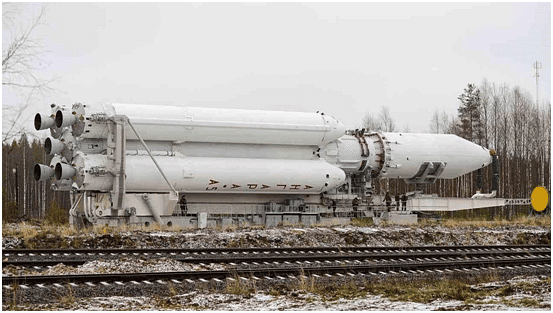
Context
A Russian rocket blasted off for a test flight on Thursday at the third try after previous launch attempts earlier this week were aborted in the final seconds of the countdown.
Angara A5 and significance
- The Angara A5 is a robust heavy-lift launch vehicle engineered to transport payloads into space.
- The rocket was launched from the Plesetsk Cosmodrome in northwest Russia, representing Russia's efforts to modernize its space program.
- This three-stage rocket is designed to carry 24.5 tonnes of payload into low orbit, serving as a replacement for the longstanding Proton M rocket.
- The launch site, situated in the forested Amur region, strategically borders China and is located 1,500 km from Vladivostok.
- The successful launch marks a significant achievement for Russia's space industry, showcasing its capability to deploy substantial payloads into orbit.
|
90 videos|490 docs|209 tests
|
FAQs on Science and Technology: April 2024 UPSC Current Affairs - Science & Technology for UPSC CSE
| 1. What is the current status of the Fukushima water issue? |  |
| 2. What is the significance of the first home-grown gene therapy for cancer? |  |
| 3. How does the Kodaikanal Solar Observatory contribute to scientific research? |  |
| 4. What are shallow fakes and why are they a growing concern? |  |
| 5. How does the Green Steel Policy aim to reduce carbon emissions in the steel industry? |  |





















